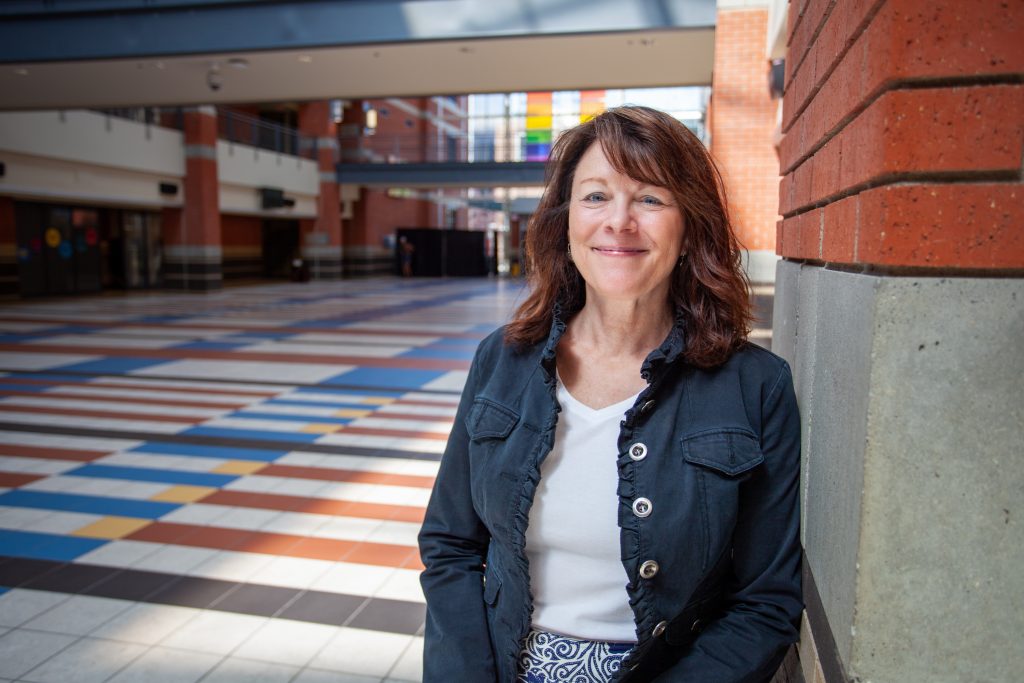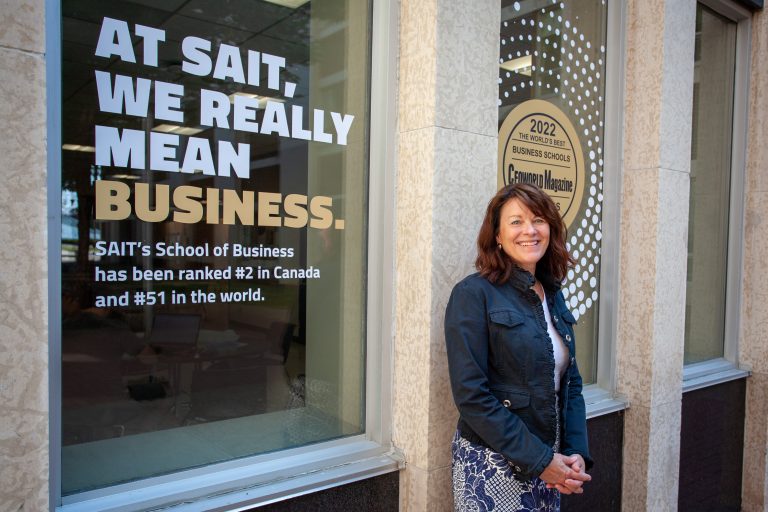
When Loanne Benner took part in her first post-secondary course in 2001, it ignited a lifelong love of learning—one that propelled her towards the Master of Management at UBC Okanagan and a fulfilling career today as Academic Chair for Journalism and Library Information Technology Programs at the Southern Alberta Institute of Technology (SAIT) School of Business.
“I’m responsible for a multitude of things, including leading faculty and making sure that the programs are viable, and meeting the needs of our students” she explains. “The programs I oversee are undergoing a redesign, which involves reaching out to industry to create program advisory committees. If you’d asked me four years ago, before the Master of Management, would I be confident doing that? I don’t think so.”
A journey of discovery
Loanne’s position today is long way from where she began as a filing clerk with the Government of Alberta. “I started when I was really young, and I didn’t have any post-secondary education,” she shares. “I worked my way up through every job possible, for 18 years, until I became a manager. And that was about as far as I could go with the education I had.”
Loanne took a management certificate at SAIT to expand her skillset and, when it was completed, found herself craving more. When her supervisor encouraged her to take a one-year leave of absence to try undergraduate studies, she leapt at the opportunity to expand her horizons. She enrolled in 2003 at the University of Calgary and, after graduating with a Bachelor of Arts in Psychology in 2007, joined SAIT Polytechnic as an HR specialist, before moving to a series of management roles in three different schools. In 2017, post-graduate studies beckoned.
“I guess I never really lost the desire to keep learning,” she reflects. “When the Master of Management program opened up at UBCO, it really intrigued me. It was so different than anything I’d seen before in the way it was structured.”
Expanding horizons
Loanne was drawn in by the program’s emphasis on integrated, applied learning, and by its focus on innovation and sustainability. “I thought, ‘These are things that I’m very, very interested in.’ Everything about it just struck me as something that would push me a little bit beyond my limits—and I could also use those new perspectives to bring back to the work that I was doing at SAIT.”
She was accepted into a diverse cohort of learners with unique backgrounds and life experience in the program’s first year.
“I was a bit worried about coming in as someone a little later in my career, but it was a really accepting, cohesive group”
The group’s diversity helped to enhance her learning, she adds. “It really added to the collaborative approach. It was fascinating to hear people’s experiences with whatever topic we were discussing. Each person brought their own experience to it and their own feedback on how they handled certain challenges.”
Loanne also appreciated the focus on applied problem-solving, which complemented her work at SAIT. “The program is so focused on looking at real-world problems, and then coming back and taking the theory and saying, ‘How would we solve these problems?’” she notes. “What better way to apply the theory than to actually go to organizations and say, ‘What’s happening? What are you facing today? What can we do to come up with a solution to that problem?’”
Uncovering new opportunities
For her applied project, Loanne delved into change-management theory, and looked at how it applied to SAIT. “At that time, SAIT was going through tremendous change, and we were restructuring and trying to do more with less. The change-management piece really appealed to me. It was so applicable within my own work environment that it was the perfect opportunity to dig into the theory and look at how to apply it to SAIT.”
She continues to draw on her learnings from that project today, alongside other insights and experiences from her time in the MM program. “The innovation piece sticks with me as well,” she shares.
“The program really opened up my eyes to what innovative thinking is, and what it means to put it into action”
“We’ve had a lot of opportunity at SAIT, especially during COVID-19, to try to think and work innovatively, try to think outside the box, and ask: How do we do what we’ve always done, and do it successfully, remotely? And, as things continue to shift, how do we take the lessons we learned and the improvements made as we adapted, and continue to build on them?”
Above all, she says, being in the MM program helped her expand her understanding of her own skills and abilities. “It gave me a lot more confidence to have a voice at the table,” she says. “Going through the program, I started to notice in meetings that I would speak up, and speak from experience and speak from knowledge, and people started listening to me. And then I started to think, why can’t I be an Academic Chair?”
She successfully applied for an Academic Chair role with the SAIT School of Construction in 2021, and moved into her role with the Journalism and Library Information Technology Programs last year with the SAIT School of Business. “Because of the MM program, I felt like I had way more to offer,” she says, looking back on her time at UBC Okanagan. “It’s so exciting to be involved in the education side of things and have that hands-on experience with faculty and students. And I don’t think that would’ve happened if I hadn’t done the MM.”
